Discover 35 hidden attractions, cool sights, and unusual things to do in Quebec City (Canada). Don't miss out on these must-see attractions: Citadelle of Quebec, Musée de la civilisation, and Montmorency Falls. Also, be sure to include Chateau St. Louis in your itinerary.
Below, you can find the list of the most amazing places you should visit in Quebec City (Québec).
Table of Contents
Citadelle of Quebec
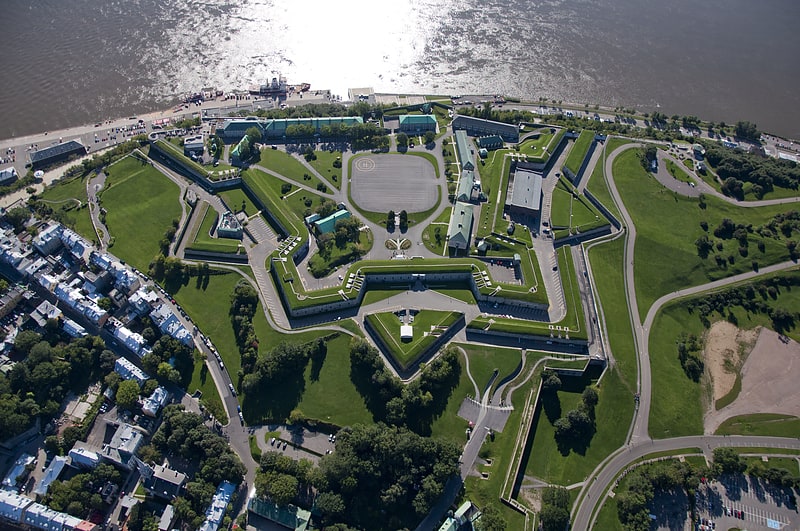
Museum and active fort with a long history. The Citadelle of Quebec, also known as La Citadelle, is an active military installation and the secondary official residence of both the Canadian monarch and the governor general of Canada. It is located atop Cap Diamant, adjoining the Plains of Abraham in Quebec City, Quebec. The citadel contains the oldest military building in Canada, and forms part of the fortifications of Quebec City, which is one of only two cities in North America still surrounded by fortifications, the other being Campeche, Mexico.
The strategic importance of Cap Diamant was recognized by the French as early as 1608. Several defensive fortifications were built on the site first by the French, and then by the British after their conquest of New France. The modern citadel was built from 1820 to 1850, in effort to secure Quebec City against a potential American attack. The British used the citadel until 1871, when they formally handed the property over to the Canadian government. Following the handover, the citadel was used as a military installation by the Canadian Armed Forces, and as a royal and viceregal residence.
The Citadelle is a National Historic Site of Canada and forms part of the Fortifications of Québec National Historic Site of Canada. The fortress is located within the Historic District of Old Québec, which was designated a World Heritage Site in 1985. The site receives some 200,000 visitors annually.[1]
Address: 1 Côte de la Citadelle, G1R 3R2 Québec (La Cite)
Musée de la civilisation
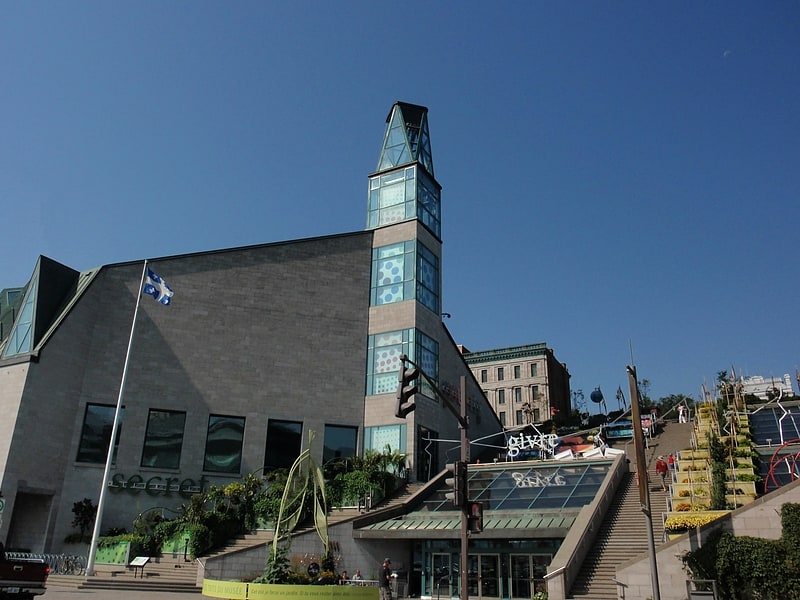
Human societies in Quebec and worldwide. The Musée de la civilisation, often directly translated in English-language media outside Quebec as the Museum of Civilization, is a museum located in Quebec City, Quebec, Canada. It is situated in the historic Old Quebec area near the Saint Lawrence River. It was designed by architect Moshe Safdie, and opened its doors to the public on 19 December 1988.
The previous buildings of the Banque de Paris and the Maison Estèbe, which were situated on Saint-Pierre street, were integrated in the museum's structure. Permanent and temporary exhibitions are held at the museum, usually related to humanities, and virtual exhibitions are also available. The institution also hosts Quartier des découvertes (Discovery Zone), geared towards children, and offers other services such as guided visits, a French America reference centre, shows, souvenir boutiques, a cafeteria, and a leisure room.[2]
Address: 85 Rue Dalhousie, G1K 8R2 Québec (La Cite)
Montmorency Falls
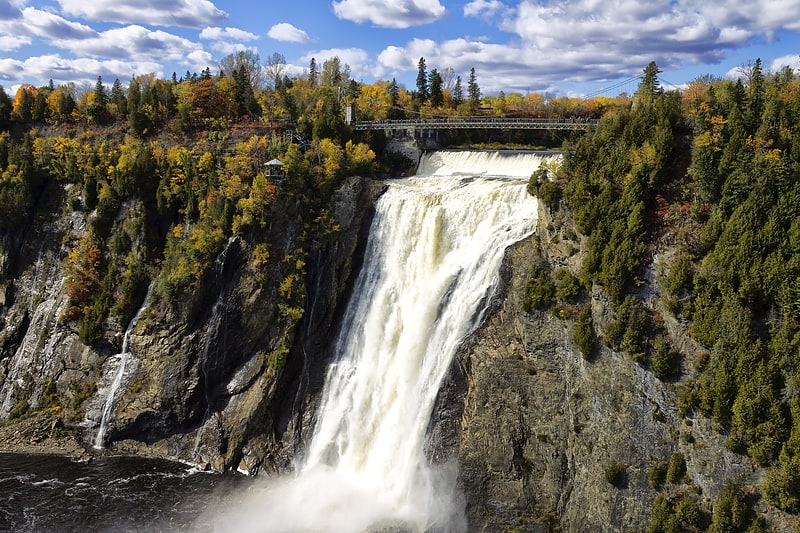
Grand waterfall surrounded by parkland. The Montmorency Falls is a large waterfall on the Montmorency River in Quebec, Canada.[3]
Address: 2490, Ave royale, G1C 7N5 Beauport (Beauport)
Chateau St. Louis
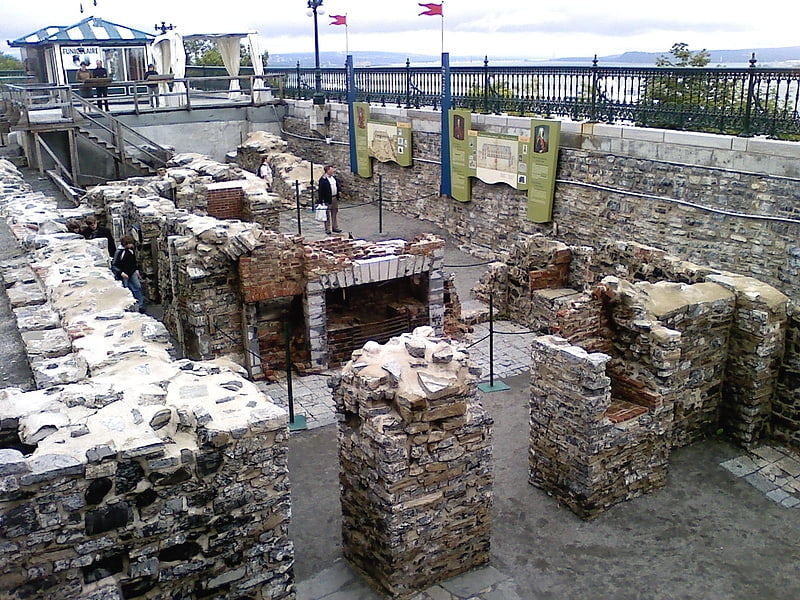
Historical landmark in Quebec City, Quebec. The Chateau St. Louis in Quebec City was the official residence of the French Governor of New France and later the British Governor of Quebec, the Governor-General of British North America, and the Lieutenant-Governor of Lower Canada.
The site was designated a National Historic Site of Canada in 2002.[4]
Musée national des beaux-arts du Québec

Art from Quebec and by Quebecois painters. The Musée national des beaux-arts du Québec, abbreviated as MNBAQ, is an art museum in Quebec City, Quebec, Canada. The museum is situated in Battlefield Park and is a complex consisting of four buildings. Three of the buildings were purpose-built for the museum. One building was initially built as a provincial prison before being repurposed for museum use.
The institution was opened as the Musée de la province de Québec in 1933. The museum was a provincial archives, arts, and natural science museum until 1962, when the natural science collection was removed. In the following year, the museum was renamed the Musée du Quebec. The provincial archives were relocated from the museum in 1979, leaving the institution with only an arts collection. In 2002, the museum was renamed the Musée national des beaux-arts du Québec.
The collection includes over 40,000 works from the 16th century to the present day. The collection primarily includes works that were produced in Quebec, or by a Quebec artist, although it also includes works from other parts of Canada, and the rest of the world. The museum is affiliated with the Canadian Museums Association, the Canadian Heritage Information Network, and the Virtual Museum of Canada.[5]
Address: 179 Grande Allée Ouest, G1R 2H1 Québec (La Cite)
Musée de l'Amérique francophone
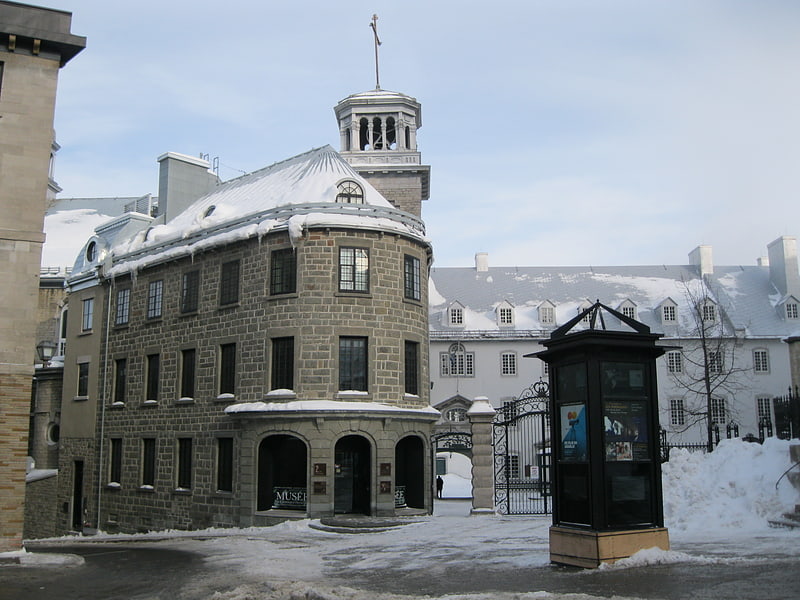
Museum in Quebec City, Québec. The Musée de l'Amérique francophone, formerly the Musée de l'Amérique française, is situated in the Old Quebec neighbourhood of Quebec City, Quebec, Canada. It is Canada's oldest museum. Its collection contains books from Séminaire de Québec's library, some of which were published in the 16th century and others which were placed in a restricted section called Enfer. It also contains artifacts from Cyprus, paintings, first-edition publications of The Birds of America and Encyclopédie, and a recreation of the organ from Cathedral-Basilica of Notre-Dame de Québec. The museum's collection has been managed by the Musée de la civilisation since 1995.[6]
Address: 2 Cote de la Fabrique, G1R 3V6 Québec (La Cite)
Cartier-Brébeuf National Historic Site

Tourist attraction in Quebec City, Québec. Cartier-Brébeuf National Historic Site is a National Historic Site of Canada and so designated by the Historic Sites and Monuments board of Canada in 1958 under the recommendation of John Diefenbaker, the Prime Minister of Canada at the time. It is administered by Parks Canada and located at the confluence of Saint-Charles and Lairet rivers, in Quebec City, Quebec, Canada, more precisely in La Cité-Limoilou borough. On the site you can find an interpretation centre and a 6,8 hectares inner-city park characterised by an uneven landscape and divided into two sectors "East" and "West" separated by the Lairet river. Several commemorative monuments and elements are also present.
The site commemorates the second voyage of Jacques Cartier; more precisely in 1535-1536 when he and his shipmates wintered near the Iroquoian village of Stadacona (Quebec City). It also recalls the establishment of the first residence of the Jesuit missionaries in Quebec, in 1625-1626.
Moreover, by the end of the 17th century up to the opening of the national historic site in 1972, it hosted numerous hand-crafted and industrial activities such as a tannery, a pottery, a brickyard, a shipyard, a sawmill, a junkyard and a snow-dumping lot.
Today, the site offers a museum exhibition, animations for elementary and high school groups, thematic events, and a natural habitat in an inner-city park. A cycleway and the linear park of Saint-Charles river also cross the park's ground.[7]
Address: 175, rue de l'Espinay, G1L 3W6 Quebec City (Limoilou)
Aquarium du Québec
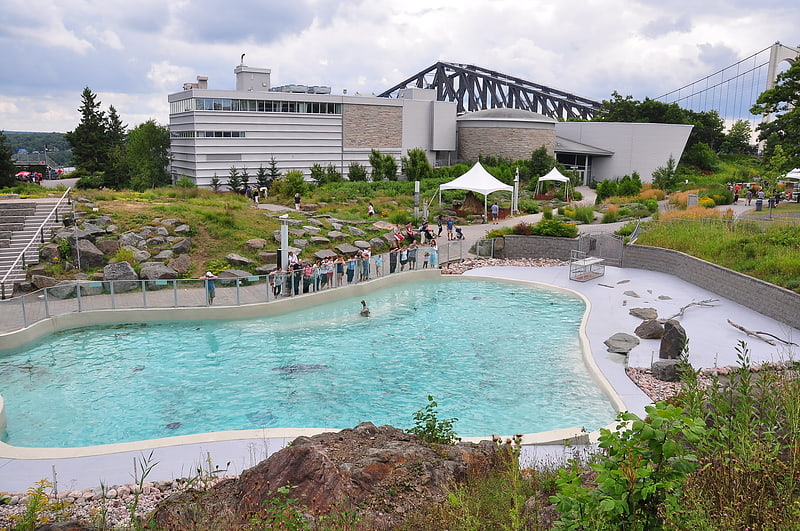
Aquarium in Quebec City, Québec. Aquarium du Québec is a public aquarium located in the former city of Sainte-Foy in Quebec City, Quebec, Canada. The 16-hectare facility is home to more than 10,000 animals representing more than 300 species. It is operated by Société des établissements de plein air du Québec, and is a member of the Canadian Association of Zoos and Aquariums.[8]
Address: 1675 des Hotels Ave, G1W 4S3 Quebec City (Sainte-Foy)
Parliament Building

Quebec's legislature and free guided tours. The Parliament Building of Quebec is an eight-floor structure and is home to the National Assembly of Quebec, located in Quebec City, Quebec, Canada. The Parliament Building was designed by architect Eugène-Étienne Taché in a Second Empire style and built between 1877 and 1886, in the heart of Quebec's Parliament Hill. The National Assembly first met there on March 27, 1884, even as the building was fully completed only two years later, on April 8, 1886. In 1910s-1930s, the government has built several adjacent buildings to expand its office spaces, creating a parliamentary complex, of which the Parliament Building is the main edifice. The government office, is a successor of several earlier buildings, the earliest of which was built in 1620 and among which there were two other parliament houses that served as legislatures from 1791.
Geographically, the building is located in the Place de l'Assemblée-Nationale, in the district of Vieux-Québec–Cap-Blanc–colline Parlementaire, part of the borough of La Cité-Limoilou, just outside the walls of Old Quebec. However, the Parliament Building, along with several adjacent buildings and terrain, have been declared a "national historic site" (French: site historique national), and as such taken away from the control of the provincial Ministry of Culture and Communications and municipalities. This designation notwithstanding, the province of Quebec is signatory to a long-term leasing deal (called emphyteusis) when it comes to the territory in front of the National Assembly, that is, from the front entrance to the fortifications of the old town, as this parcel has belonged to the federal government since 1881.[9]
Notre-Dame-des-Victoires Church
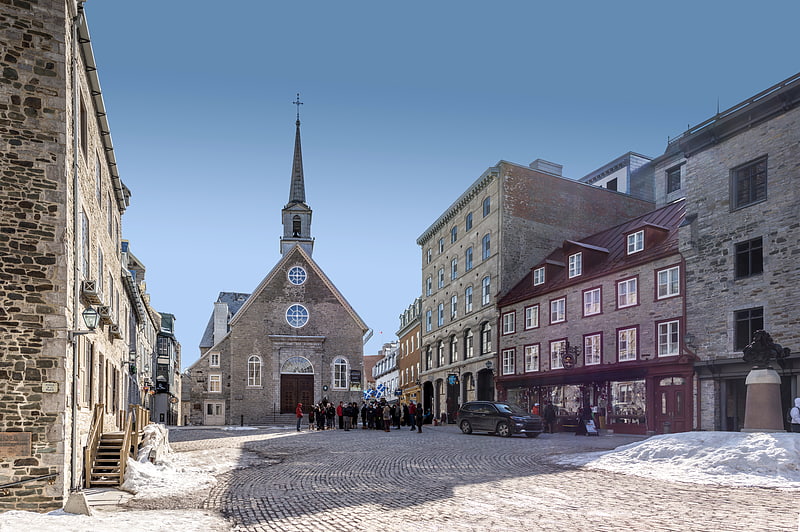
Stone church founded in the 17th century. Notre-Dame-des-Victoires is a small Roman Catholic stone church on Place Royale in the lower town of Old Quebec City. Construction was started in 1687 on the site of Champlain's habitation and was completed in 1723. The church is one of the oldest in North America.[10]
Address: 32 Rue Sous le Fort, G1K 4G7 Québec (La Cite)
Habitation de Québec
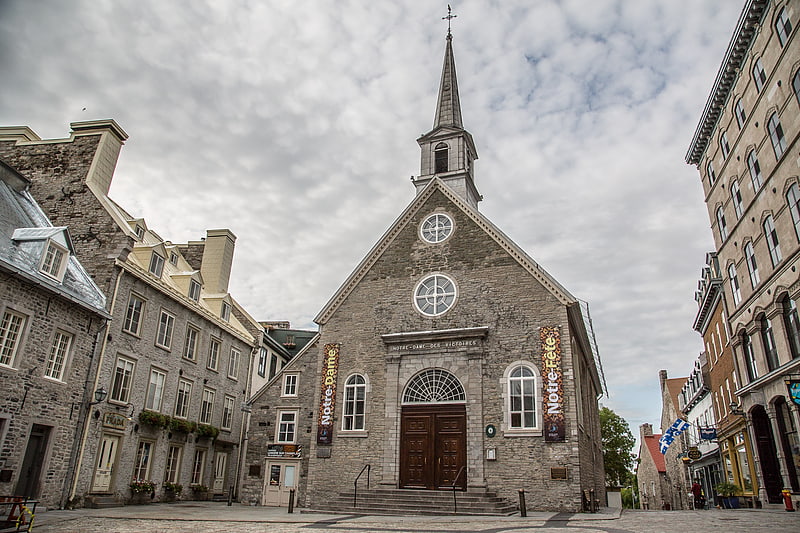
Habitation de Québec was an ensemble of buildings interconnected by Samuel de Champlain when he founded Québec during 1608. The site is located in what is now Vieux-Québec. It was located near the site of the abandoned First Nations village of Stadacona that Jacques Cartier had visited during 1535. It served as a fort and as dwellings for the new colony in New France.[11]
Address: 68, rue du Petit-Champlain, G1K 4H4 Quebec City (La Cite)
Cathedral-Basilica of Notre-Dame de Québec
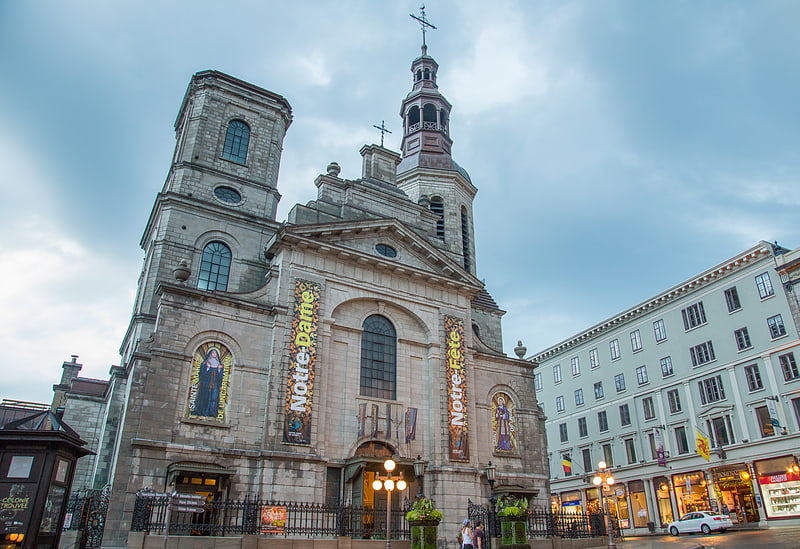
Storied church with a notable crypt. The Cathedral-Basilica of Notre-Dame de Québec, located at 16, rue de Buade, Quebec City, Quebec, is the primatial church of the Roman Catholic Archdiocese of Quebec. It is the oldest church in Canada and was the first church in Canada to be elevated to the rank of minor basilica, by Pope Pius IX in 1874. Four governors of New France and the bishops of Quebec are buried in the crypt, including François de Laval, Quebec's first bishop.
The church is a National Historic Site of Canada, and located within the UNESCO World Heritage Site of Historic District of Old Québec.[12]
Address: 16 Rue De Buade, G1R 4A1 Québec (La Cite)
Islamic Cultural Centre of Quebec City
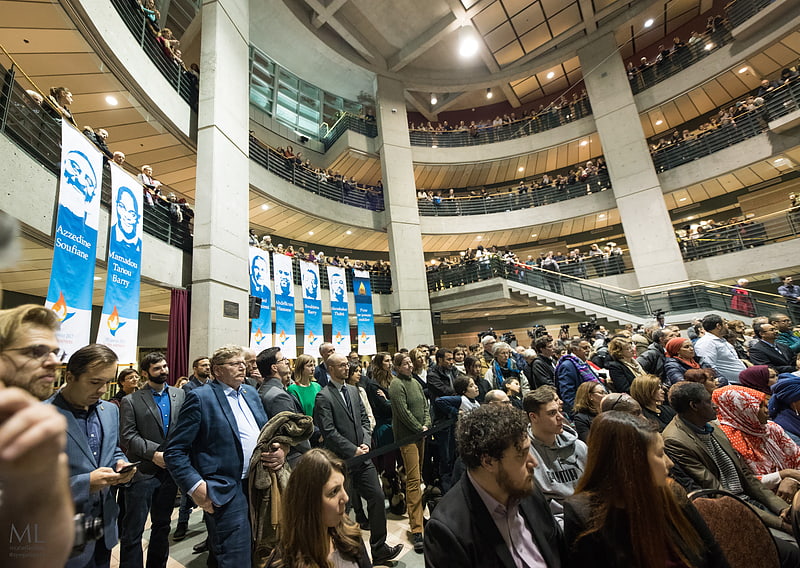
The Islamic Cultural Centre of Quebec City is an organization dedicated to meeting the spiritual, social and economic needs of the Muslim community residing in Quebec City, Quebec, Canada. Its main place of worship is the Great Mosque of Quebec City.[13]
Régiment de la Chaudière
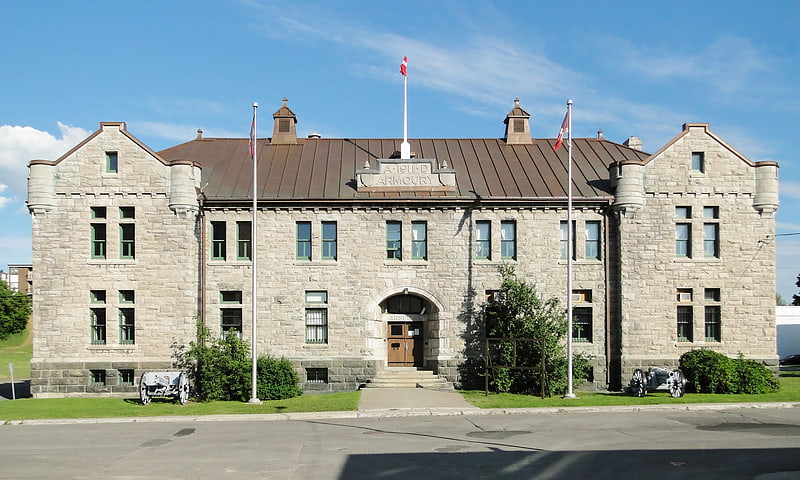
The Régiment de la Chaudière is a Primary Reserve infantry regiment of the Canadian Army. It is part of the 2nd Canadian Division's 35 Canadian Brigade Group and is headquartered at Lévis, Quebec.[14]
Address: 10 rue de l'Arsenal, G6V 4P7 Quebec City (Desjardins)
Saint-Jean-Baptiste Church

Church in Quebec City, Quebec. Saint-Jean-Baptiste Church was a church in Quebec City, Quebec located at 410, rue Saint-Jean.[15]
Address: 400, rue St-Jean, G1R 1P4 Québec (La Cite)
Mount Hermon Cemetery
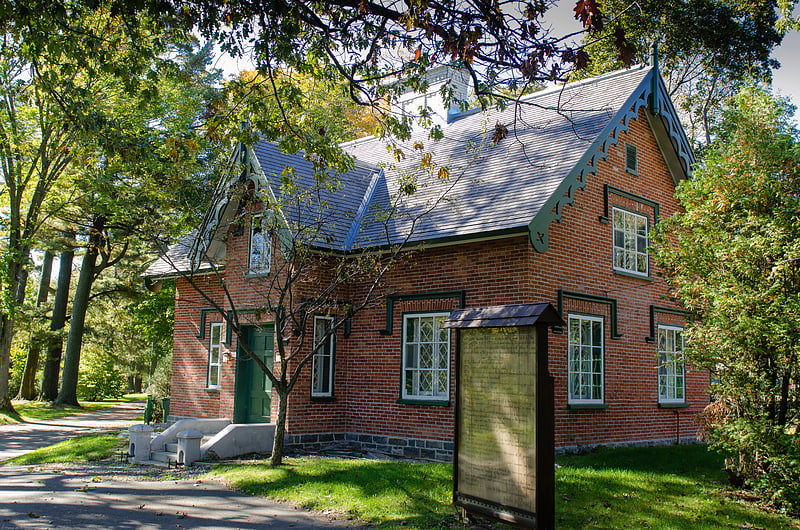
Cemetery in Quebec City, Quebec. Mount Hermon Cemetery is a garden cemetery and National Historic Site of Canada. It is located in the Sillery district of the Sainte-Foy–Sillery–Cap-Rouge borough of Quebec City, Quebec, Canada. The cemetery was designated a National Historic Site of Canada in 2007.
The impetus for the creation of the 11-hectare (26-acre) cemetery was the need for the provision of an Anglican burying ground for Quebec City's primarily English language speaking, Anglican community, in the mid–1800s.
The cemetery is located at the corner of Saint-Louis Road (French: chemin Saint-Louis) and côte de Sillery (formerly côte de l'Église), on 109,010 m2 (0.042 sq mi) of land overlooking the Saint Lawrence River, in the southeastern direction.
More than 17,000 people are buried at Mount Hermon. Mount Hermon Cemetery draws distinction as being the first garden cemetery (French: cimetière-jardin) established in Canada. Mount Hermon, and other garden cemeteries formed in North America, took inspiration from cimetière du Père-Lachaise of Paris.
A memorial was dedicated to the victims of the sinking of the shipwrecked Empress of Ireland, in 1914, and other memorials were erected at later dates on the cemetery's grounds. The major loss of lives aboard the shipwrecked Empress of Ireland had significant impact upon Mount Hermon, along with its neighboring cemetery on chemin Saint-Louis: Saint-Patrick's Cemetery, which also relocated from the city of Quebec, in 1879. Both of the cemeteries took on responsibility for a significant number of the ship's passengers whom perished aboard or at sea.
Separately, on the Mount Hermon grounds is the Treggett Bell, which was presented in gratitude to the Treggett family, who had members from four different generations of its family serve as Mount Hermon's Superintendents, encompassing the years 1865–2014.
In addition, the cemetery contains sections dedicated for individuals of Greek (French: section de la communauté grecque orthodoxe), Chinese (French: section de la communauté chinoise), and Cambodian (French: lots des cambodgiens) descent.
The main entrance is accessed at 1801 Saint-Louis Road, at the northern end of the cemetery. There is a pedestrian entrance located at the southwestern portion of the cemetery, accessed at the northern terminus of avenue des Voiliers, one-block east of côte de Sillery. The cemetery grounds contain both paved and gravel roads.[16]
Address: 1801 Chemin Saint-Louis, Quebec City (Sainte-Foy)
Cathedral of the Holy Trinity

Cathedral in Quebec City, Quebec. The Cathedral of the Holy Trinity is the cathedral of the Anglican Diocese of Quebec and home to two parishes: the Parish of Quebec and la Paroisse de Tous les Saints. It stands on the western side of Quebec City's Place d'Armes.
When it was formed the Diocese of Quebec covered both Upper and Lower Canada. Today, its territory covers 720,000 km2 in the central and eastern parts of the province of Quebec but does not include the area around Montreal. It has 7,817 Anglicans on the parish rolls in 93 congregations. The Cathedral of the Holy Trinity was designated a National Historic Site of Canada in 1989 and plaqued in 1993. It has also been designated under provincial heritage legislation.[17]
Address: 31 Rue des Jardins, G1R 3Y9 Québec (La Cite)
Quebec Bridge
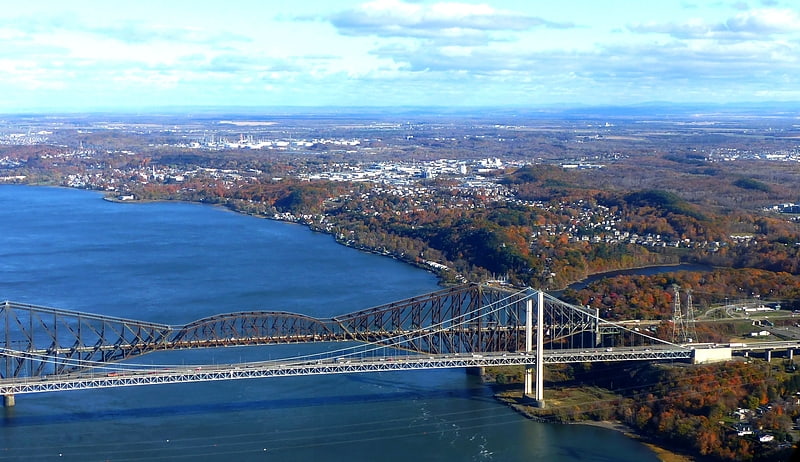
Pedestrian bridge in Québec, Canada. The Quebec Bridge is a road, rail, and pedestrian bridge across the lower Saint Lawrence River between Sainte-Foy and Lévis, in Quebec, Canada. The project failed twice during its construction, in 1907 and 1916, at the cost of 88 lives and additional people injured. It took more than 30 years to complete and eventually opened in 1919.
The Quebec Bridge is a riveted steel truss structure and is 987 m (3,238 ft) long, 29 m (95 ft) wide, and 104 m (341 ft) high. Cantilever arms 177 m (581 ft) long support a 195 m (640 ft) central structure, for a total span of 549 m (1,801 ft), still the longest cantilever bridge span in the world. (It was the all-categories longest span in the world until the Ambassador Bridge was completed in 1929.) It is the easternmost (farthest downstream) complete crossing of the Saint Lawrence River.
The bridge accommodates three highway lanes (there were none until 1929, when one was added; another was added in 1949 and a third in 1993), one rail line (two until 1949), and a pedestrian walkway (originally two). At one time, it also carried a streetcar line. Since 1993, it has been owned by the Canadian National Railway.
The Quebec Bridge was designated a National Historic Site in 1995.[18]
Address: Route 175, Quebec City
Plains of Abraham
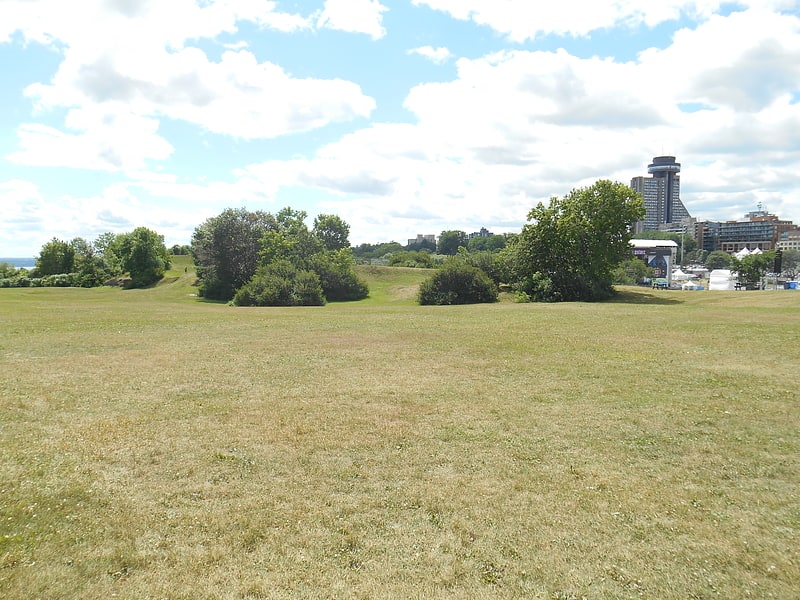
Colonial battle site in a storied park. The Plains of Abraham is a historic area within the Battlefields Park in Quebec City, Quebec, Canada. The land is the site of the Battle of the Plains of Abraham, which took place on 13 September 1759, but hundreds of acres of the fields became used for grazing, housing, and minor industrial structures. Only in 1908 was the land ceded to Quebec City, though administered by the specifically created and federally-run National Battlefields Commission. The park is today used by 4 million visitors and tourists annually for sports, relaxation, outdoor concerts, and festivals.[19]
Address: 835, Wilfrid-Laurier Avenue, level 0, Québec, Québec, G1R 2L7, Quebec City (La Cite)
Chaudière Falls
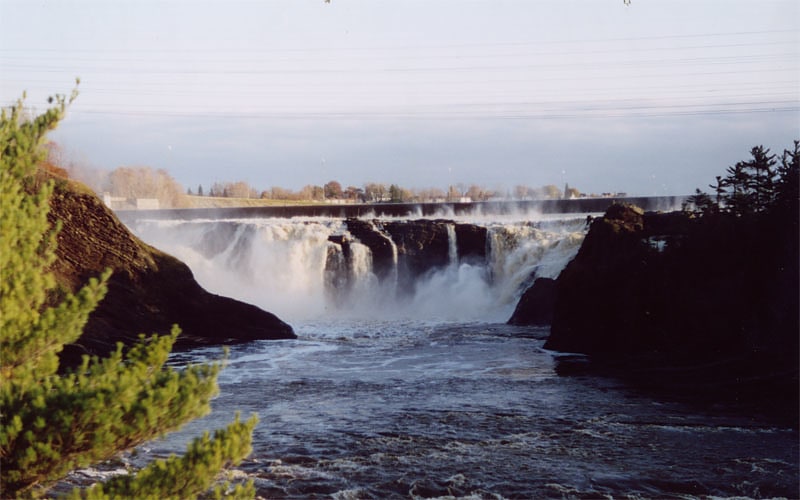
Waterfall in Québec, Canada. Chaudière Falls is a 35-meter-high waterfall in Lévis, Quebec along the Chaudière River. It is part of the regional Parc des Chutes-de-la-Chaudière, which features a 113-metre-long suspension footbridge standing 23 metres over the river. There are walking and bicycle trails along the river.[20]
Ramparts of Quebec City

The ramparts of Quebec City is a city wall that surrounds the western end of Old Quebec's Upper Town in Quebec City, Quebec, Canada. The ramparts date back to the 17th century, with the ramparts having undergone a succession of modifications and improvements throughout its history. The city walls extends 4.6 kilometres, with the southern portions of the ramparts forming a part of the Citadelle of Quebec.
The ramparts were first built in 1690 in order to defend the Upper Town of Quebec City. In 1745, the walls were rebuilt further west, modelled after designs created by Gaspard-Joseph Chaussegros de Léry. The ramparts withstood several sieges during the mid-18th century, with British forces holding out in the walled city during the French siege of Quebec in 1760, and the American siege of Quebec in 1775. From the 1820s to 1830s, the British expanded and improved the ramparts and the rest of the city's defensive network. However, by the late-19th century, several deteriorating facilities associated with Quebec City's fortifications were demolished, although the primary defences remained. In 1948, the ramparts were designated as a part of the larger Fortifications of Québec National Historic Site. The fortifications, alongside the rest of Old Quebec, were designated as a UNESCO World Heritage Site in 1985; with the area serving as the only intact example of a fortified colonial settlement in North America north of Mexico.[21]
Jesuit Chapel
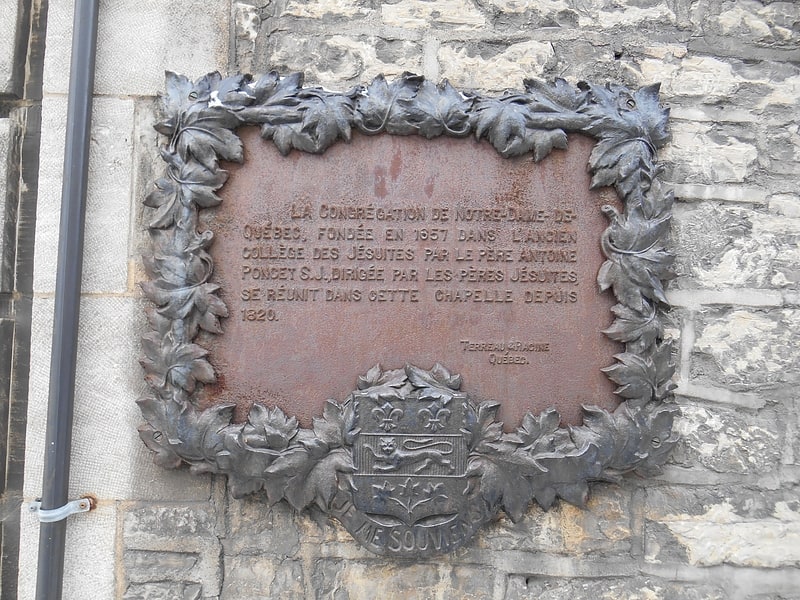
Chapel. The Jesuit Chapel is a chapel of the Society of Jesus located in the Old Quebec neighbourhood of Quebec City, Quebec, Canada. It was designed by François Baillairgé and built in from 1818 to 1930. It is situated on Rue Dauphine in Old Quebec close to the ramparts of Quebec City.[22]
Address: 20 rue Dauphine, G1R 3W8 Quebec City (La Cite)
City Hall of Quebec City

City or town hall in Quebec City, Quebec. The City Hall of Quebec City is the seat of local government in Quebec City, Quebec, Canada. It was inaugurated on September 15, 1896 in the Old Quebec neighbourhood. The building slopes downward as it was built on a hill and was once home to the Jesuit College from the 1730s to 1878.
The city hall was designated a National Historic Site of Canada in 1984. The building is also located within the "Arrondissement historique du Vieux-Québec" (Historic District of Old Quebec), a district that was designated under provincial heritage legislation in 1963 and listed as a World Heritage Site in 1985.
Located on rue des Jardins and designed by architect Georges-Émile Tanguay (1858-1923), it is the second permanent city hall for the old city. From 1842 to 1896 City Hall sat at home of British Army Major General William Dunn (British officer), son of former administrator Thomas Dunn (lieutenant-governor) (at rue Saint-Louis and rue Sainte-Ursule). Prior to 1842 the city government sat a various sites. The formal Quebec City Council was established in 1833.
The building used a mixture of Classical, Medieval and Châteauesque elements.[23]
Address: Quebec City, 2, rue des Jardins, Quebec City, Quebec, G1R 4S9
Pierre Laporte Bridge

Suspension bridge in Lévis, Quebec. The Pierre Laporte Bridge is the longest main span suspension bridge in Canada. It crosses the Saint Lawrence River approximately 200 metres west of the Quebec Bridge between Quebec City and Lévis, Quebec. It is the longest non-tolled suspension bridge in the world.
It was originally named the New Quebec Bridge and was supposed to be called Pont Frontenac (Frontenac Bridge) until it was renamed in honour of Quebec Vice-Premier Pierre Laporte, who was kidnapped and murdered during the October Crisis of 1970 as construction of the bridge was nearing completion. The bridge was constructed for the Province of Quebec, Department of Roads in a joint venture with the private firm of Parsons Transportation Group.
It carries Autoroute 73, north from Autoroute 20, the Trans-Canada Highway, to Quebec City and Autoroute 40, and northwards towards Saguenay.[24]
Address: Autoroute 73, Quebec City
St. Michel de Sillery Church

Parish church in Quebec City, Québec. St. Michel de Sillery Church is a Roman Catholic parish church in Sillery, Quebec City. It is situated between Quebec Route 136 to the south and the College of Jesus and Mary of Sillery to the north, and is part of the Sillery Heritage Site in the borough of Sainte-Foy–Sillery–Cap-Rouge. Although the current church was built in 1852, and originally dedicated to the Irish Saint Columba, the parish was founded in 1644, with a chapel constructed on the same site by the Jesuits.[25]
Chute Kabir Kouba
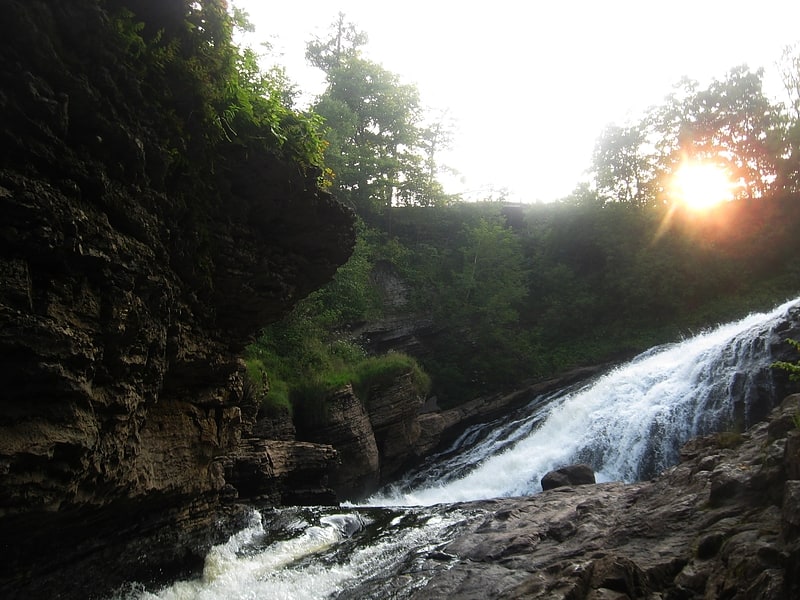
The Park of the Kabir Kouba Cliff and Waterfall is a public park in Quebec City, Quebec crossed by the Saint-Charles River. The rapids and falls of this section of the river are called Kabir Kouba the «river of a thousand bends» in the Montagnais language. An interpretive center and trails permit the observation of the Kabir Kouba waterfall that has a height of 28 metres. The trails also provide a view of the canyon which at its highest point measures 42 metres as well as a rich variety of flora, fauna and fossils dating over 455 million years old. The interpretive center also offers services such as Kabir Kouba by Lantern, A Day at Loretteville package as well as guided visits of the falls. A song by the singer Claire Pelletier, Kabir Kouba, evoques the many Huron legends that honour the river and the waterfall.[26]
Impérial Bell
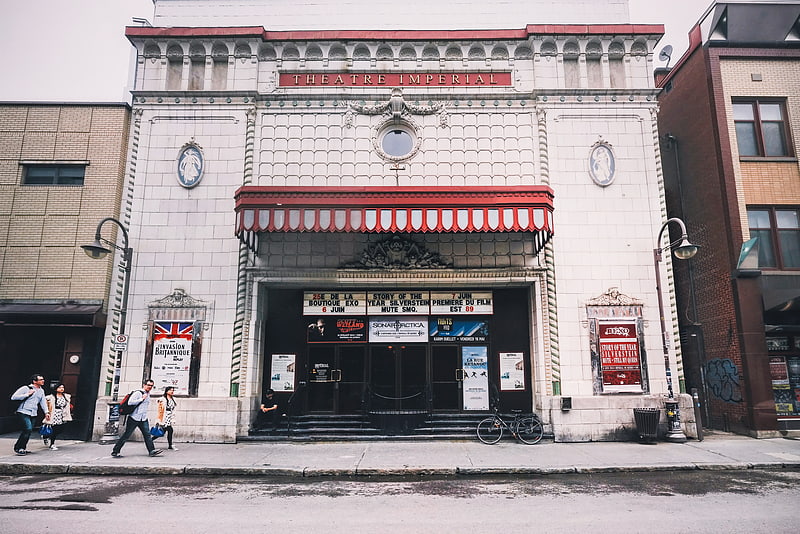
Performing arts theater in Quebec City
Address: 252 Rue Saint-Joseph Est, G1K 3A9 Quebec City (La Cite)
Beth Israel Cemetery
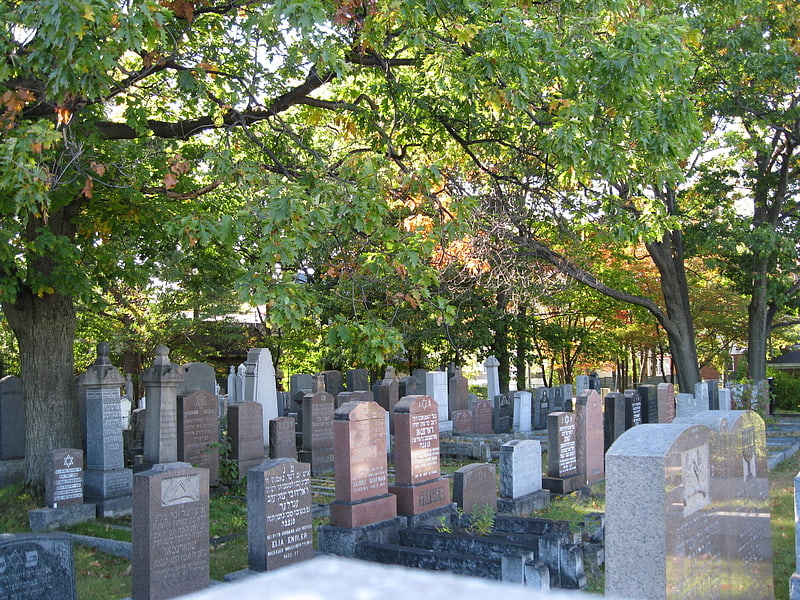
Beth Israel Cemetery is a 1-acre cemetery in the borough of Sainte-Foy–Sillery–Cap-Rouge, Quebec City, Quebec, Canada. It is a National Historic Site of Canada.[27]
Address: 2052 Boulevard René-Lévesque Ouest, Quebec City (Sainte-Foy)
Centre Vidéotron
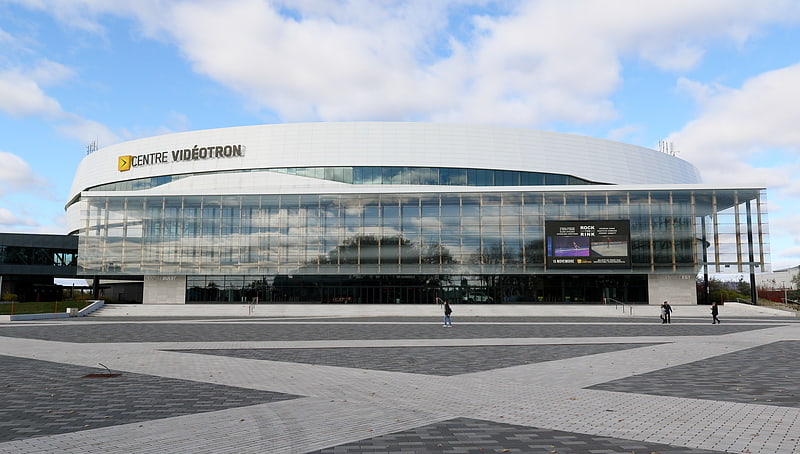
Arena in Quebec City, Quebec. Vidéotron Centre is an indoor arena in Quebec City, Quebec, Canada. The 18,259-seat arena replaced Colisée Pepsi as Quebec City's primary venue for indoor events. The arena is primarily used for ice hockey, serving as the home arena of the Quebec Remparts of the QMJHL and has been prospected as a venue for a new or re-located National Hockey League team in Quebec City, and as part of a Winter Olympic Games bid. The building opened on September 8, 2015. It is now the seventh-largest indoor arena in Canada, and the largest that does not host an NHL team.[28]
Capitole de Québec
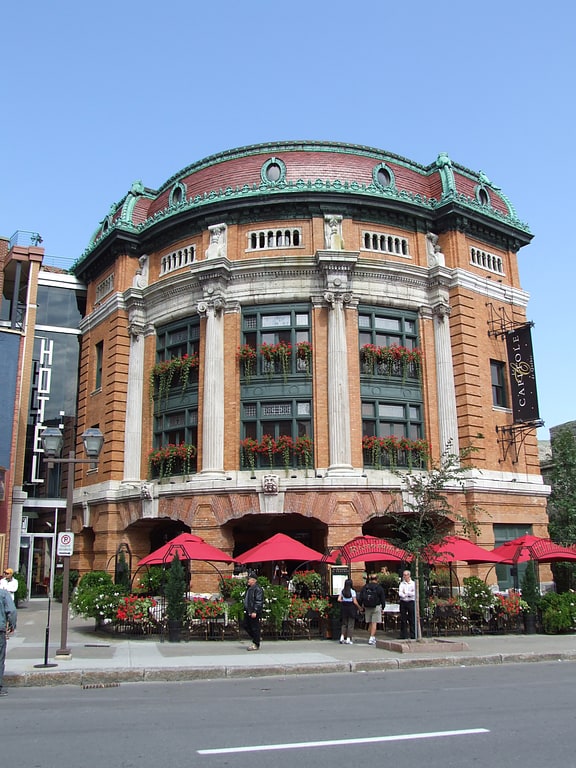
Theatre in Quebec City, Québec. The Capitole de Québec is a Beaux Arts-style theatre in Quebec City, Quebec, Canada. It is located in Old Quebec on Place d'Youville. It was listed on the Répertoire du patrimoine culturel du Québec in 1984, and became a National Historic Site of Canada in 1986.[29]
Address: 972 Rue Saint-Jean, G1R 1R5 Quebec City (La Cite)
Terrasse Dufferin
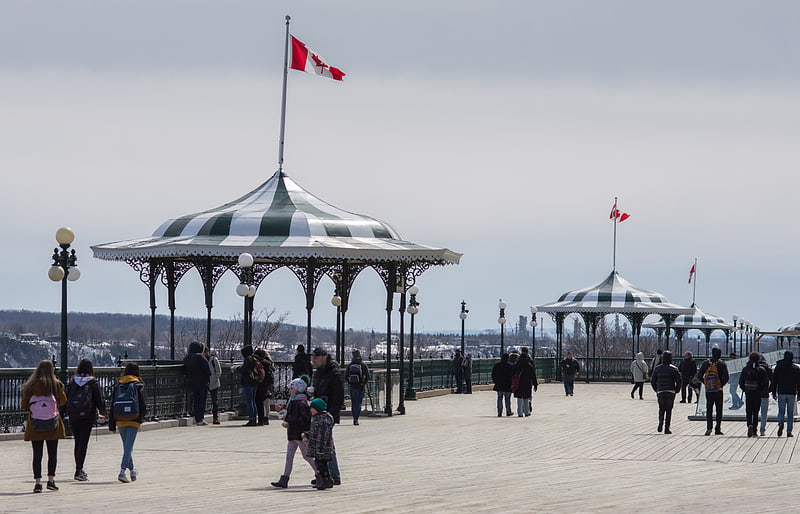
Historical landmark in Quebec City, Quebec. Terrasse Dufferin is a boardwalk that wraps around the Château Frontenac in Quebec City, Canada, towards Citadelle of Quebec, overlooking the St. Lawrence River.[30]
Address: 2, rue d'Auteuil / D'Auteuil street, 2, G1R 5C2 Quebec City (La Cite)
Government House
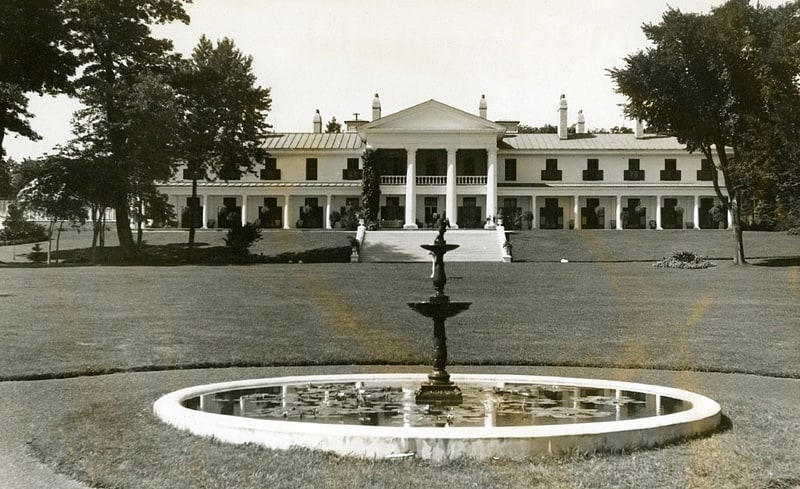
Horticultural park with gardens and trails. Quebec's Government House, known as Spencer Wood, was the viceregal residence of Quebec. It was built in 1854. Located at Bois-de-Coulonge Park in Sillery, it was purchased by the Quebec government in 1870, and served as the residence of Quebec lieutenant governors until 1966, when a major fire destroyed the main residence.[31]
Place D'Youville
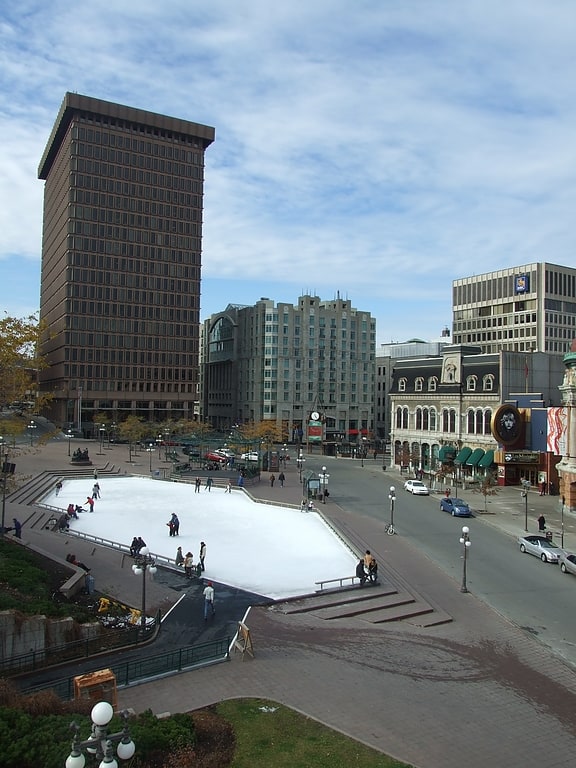
Park in Quebec City, Quebec. Place D’Youville, also referred to as carré D'Youville, is a public square in the core of Quebec City, Quebec, Canada. It is situated on rue Saint-Jean, one of the oldest roads in Quebec City. It marks the boundary between the Quebec Parliament Hill and Old Quebec. The square is named in honour of Marie-Marguerite d'Youville, a French Canadian widow who founded the religious order known as the Grey Nuns of Montreal.
In addition to the square itself, Place D'Youville is also used to refer to the area surrounding the bus terminal for the Réseau de transport de la Capitale (Quebec City's transit system), the Palais Montcalm, and the Théâtre Capitole de Québec.
Part of the square is transformed into a skating rink during winter months, and to its west is the sculpture "The Muses" by Alfred Laliberté, donated by the Government of Quebec for the 375th anniversary of the city in 1983.[32]
Château Frontenac
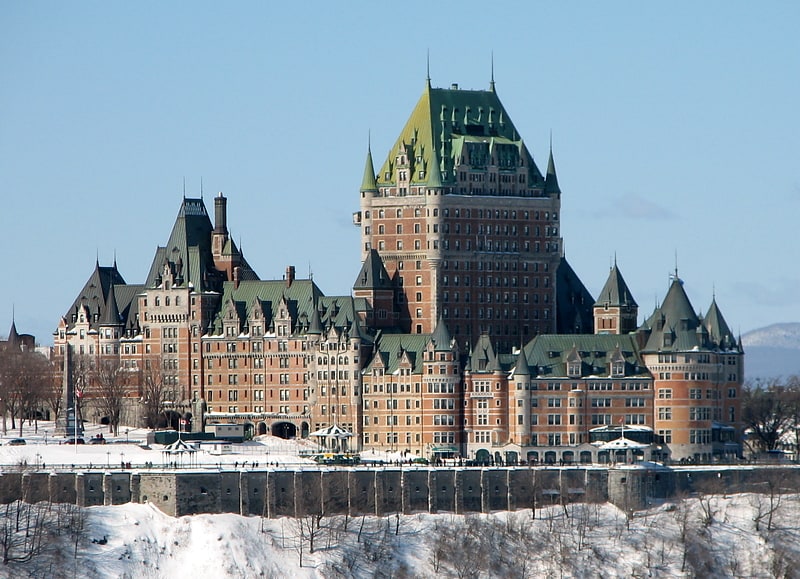
Luxe castle hotel with posh dining. The Fairmont Le Château Frontenac, commonly referred to as the Château Frontenac, is a historic hotel in Quebec City, Quebec, Canada. The hotel is situated in Old Quebec, within the historic district's Upper Town, on the southern side of Place d'Armes. The Château Frontenac was designed by Bruce Price, and was built by the Canadian Pacific Railway company. The hotel is managed by Fairmont Hotels and Resorts.
Opened in 1893, the Châteauesque-styled building has 18 floors; its 79.9-metre (262-foot) height is augmented by the 54 m (177 ft) elevation it sits at. It is one of the first completed grand railway hotels, and was designated a National Historic Site of Canada in 1981. The hotel was expanded on three occasions, with the last major expansion taking place in 1993.[33]
Address: Quebec City, 1, rue des Carrières, Quebec City, Quebec, G1R 4P5
Parc Montmorency
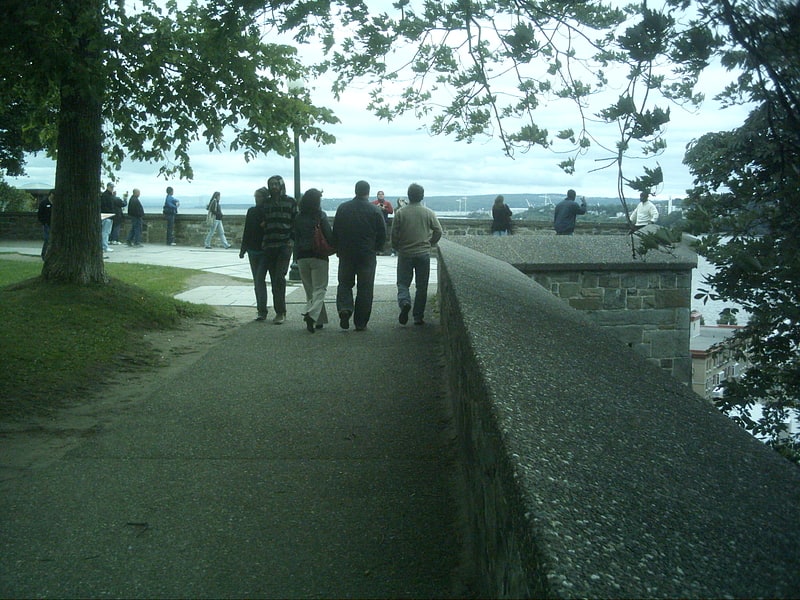
Historical landmark in Quebec City, Quebec. Parc Montmorency is a park located in Quebec City and home to Parliaments of Lower Canada, Canada East and Quebec from 1791 to 1883. It is named for Henri II, Duke of Montmorency, the viceroy of New France, 1619–1625, under the French king, Louis XIII.
The site sits above the St. Lawrence River and bounded by Côte de la Montagne and Rue Port Dauphin. The last building was demolished in 1883 and in 1894 city opened it as Parc Frontenac.
The park is partially covered by trees with walkways and signs describing the historical importance of the site.
In 1949 the park was recognized as a national historic site.[34]
Address: Rue Port-Dauphin/Rue Cote de la Montagne, G1K 4E2 Quebec City (La Cite)